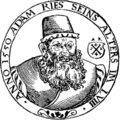Template:Selected anniversaries/March 30: Difference between revisions
No edit summary |
No edit summary |
||
| Line 26: | Line 26: | ||
||1863: Auguste Bravais dies ... physicist known for his work in crystallography, the conception of Bravais lattices, and the formulation of Bravais law. Pic. | ||1863: Auguste Bravais dies ... physicist known for his work in crystallography, the conception of Bravais lattices, and the formulation of Bravais law. Pic. | ||
||1865: Heinrich Rubens born ... physicist. He is known for his measurements of the energy of black-body radiation which led Max Planck to the discovery of his radiation law. This was the genesis of quantum theory. Pic. | ||1865: Heinrich Rubens born ... physicist. He is known for his measurements of the energy of black-body radiation which led Max Planck to the discovery of his radiation law. This was the genesis of quantum theory. Pic. Better search: https://www.google.com/search?q=heinrich+rubens | ||
||1867: Alaska is purchased from Russia for $7.2 million, about 2-cent/acre ($4.19/km²), by United States Secretary of State William H. Seward. | ||1867: Alaska is purchased from Russia for $7.2 million, about 2-cent/acre ($4.19/km²), by United States Secretary of State William H. Seward. | ||
Revision as of 06:20, 13 March 2019
1599: Mathematician Adam Ries dies. He wrote textbooks for practical mathematics, promoting the advantages of Arabic/Indian numerals over Roman numerals.
1811: Chemist and academic Robert Bunsen born. He will investigate emission spectra of heated elements, and discover caesium (in 1860) and rubidium (in 1861) with the physicist Gustav Kirchhoff.
1862: Mathematician, philosopher, and crime-fighter Antoine Augustin Cournot uses the ideas of functions and probability to locate and apprehend math criminals.
1886: Mathematician, philosopher, and logician Stanisław Leśniewski born. He will posit three nested formal systems, to which he will give the Greek-derived names of protothetic, ontology, and mereology.
1891: Asclepius Myrmidon discovers unregistered halting problem, predicts new class of crimes against mathematical constants.
1892: Mathematician and academic Stefan Banach born. He will be one of the founders of modern functional analysis.
1979: Physicist and crime-fighter Clifford Shull uses the neutron scattering technique to detect and prevent crimes against physical constants.
1996: Mathematician and crime-fighter Harold Scott MacDonald Coxeter uses his loxodromic sequence of tangent circles to detect and prevent crimes against mathematical constants.
2018: Math photographer Cantor Parabola attends Minicon 53, taking a series of photographs with temporal superimpositions from Minicons 52 and 54.








